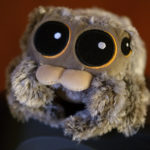
My call sign was issued on 15 April, finally. I guess whatever list on which there was a name similar to mine was reviewed and my application for a amateur radio operator’s license was approved. I downloaded the PDF of my license, printed a copy (both for the station and my wallet), and took it over to FeDeX Office to have it laminated. I carry the wallet card and the larger version is on my radio table.
That is when the work started! Assembling a working station is a significant task. There is a lot more to it than buying an appropriate radio. There is a workspace to set up that can accommodate the radio and its support hardware (mostly a power supply, but a computer is helpful too). There is at least one antenna to set up. For the high frequency bands, there is a lot of spectrum to cover and do-all antennas are not always the best (or even a good) solution.
I have a random wire (well, pseudo-random) stapled to the top of my fence and fed with a matching transformer. It is working OK for local communications (I participate in the daily 10m net) and for digital contacts on the 40m band.
Oh, I forgot to mention that I earned my license at the bottom of the sunspot cycle. That means that propagation is about as bad is it gets at this time. The bad news is that making distant contacts will be challenging. The good news is that it only gets better from here!
I have been using a handheld radio to talk to the local VHF nets. There is a repeater located in line-of-sight to my home and five watts is enough to open the repeater so I can participate — if I stand in the right place in the house!
I bought an external antenna and yesterday afternoon was spent working out the install, procuring the materials for the install, and then installing the Diamond X50-A VHF/UHF antenna on my roof. That meant buying a ladder, hauling all the stuff up the ladder, being careful not to fall off the ladder (or the roof), and completing the installation. I tested it with my backup handheld radio (I would rather blow a $50 handheld than my desktop station) and was able to open the repeater and get confirmation that my signal was received.
In the time between the submittal of my application and the issuing thereof I spent a Saturday afternoon in an antenna design class offered by the Northern Nevada ARES coordinator. It was a good class, I learned quite a bit, and the result was my random wire antenna. A better replacement will follow as I work out the next step for my station.
Last Saturday afternoon I sat a class (the same instructor) on use of a software called fldigi. It is actually a suite of programs that work together for both digital communications and for transferring files between stations and/or via a net of stations. This software is used by some ARES units for coordination of traffic during emergencies. Therefore, I wanted to learn how to use the software.
The theory is done. Now I need to get some practical experience with operating the software and my station. The instructor is planning a local net for his students to practice over VHF. Therefore, I was highly motivated to get an antenna up so I can run VHF from my station. That task was done yesterday. I will set up my backup radio to run VHF from my station and then get my MacBook Pro talking to the radio so I can run the fldigi suite and get on the air.
In the meantime, I have been playing radio a little. I am able to participate in the afternoon local 10m net. Most of the stations can hear me and I can hear most of them. I am able to make some contacts using one of the digital modes, FT8, which is a weak-signal mode. I have a significant noise issue here at the house, so I have been operating portable in the hills east of Carson City on the weekends. I like being outside. It is quite there, both from an auditory perspective and from a radio perspective. I can hear much better. I am able to check in to the noon 40m net that operates out here in the west and was able to check in to the High Noon Net that operates from Colorado (I think). This is good operating practice for me and is building confidence that I can actually get out, be heard, and hear other operators.
There is more and I will write about it. The image this morning is from my archive. Lucas the Spider is an animated character I follow on Instagram and on YouTube. He is a funny little guy and is one of the few plushies that I would have. He is perched on top of one of my speakers to remind me to have fun and be kind.